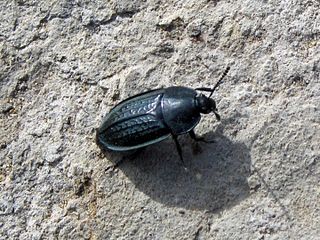
Silphidae is a family of beetles that are known commonly as large carrion beetles, carrion beetles or burying beetles. There are two subfamilies: Silphinae and Nicrophorinae. Members of Nicrophorinae are sometimes known as burying beetles or sexton beetles. The number of species is relatively small, at around two hundred. They are more diverse in the temperate region although a few tropical endemics are known. Both subfamilies feed on decaying organic matter such as dead animals. The subfamilies differ in which uses parental care and which types of carcasses they prefer. Silphidae are considered to be of importance to forensic entomologists because when they are found on a decaying body they are used to help estimate a post-mortem interval.

Histeridae is a family of beetles commonly known as clown beetles or hister beetles. This very diverse group of beetles contains 3,900 species found worldwide. They can be easily identified by their shortened elytra that leaves two of the seven tergites exposed, and their geniculate (elbowed) antennae with clubbed ends. These predatory feeders are most active at night and will fake death if they feel threatened. This family of beetles will occupy almost any kind of niche throughout the world. Hister beetles have proved useful during forensic investigations to help in time of death estimation. Also, certain species are used in the control of livestock pests that infest dung and to control houseflies. Because they are predacious and will even eat other hister beetles, they must be isolated when collected.

Trogidae, sometimes called hide beetles, is a family of beetles with a distinctive warty or bumpy appearance. Found worldwide, the family includes about 300 species contained in four or five genera.

Aleochara is a genus in the beetle family Staphylinidae, the rove beetles. Larvae of Staphylinidae occur in many assorted ecological roles, most being scavengers, predators or carrion feeders, but the larvae of at least those species of Aleochara whose life histories are known are parasitoids. They feed in the puparia of suitable species of flies, killing the host in the process. Adult Aleochara are predators.

Nitidula is a genus of sap-feeding beetles in the family Nitidulidae. There are more than 20 described species in Nitidula. Some species breed in carrion while others are associated with later stages of decay in mammalian corpses and can be used in forensic investigations.

Apteroloma is a genus of primitive carrion beetles in the family Agyrtidae. There are about 14 described species in Apteroloma.

Agyrtes is a genus of primitive carrion beetles in the family Agyrtidae. There are at least four described species in Agyrtes.

Lyrosoma is a genus of primitive carrion beetles in the family Agyrtidae. There are at least three described species in Lyrosoma.

Thanatophilus is a genus of carrion beetles in the family Silphidae. There are about 12 described species in Thanatophilus.

Necrophilus is a genus of primitive carrion beetles in the family Agyrtidae. There are at least three described species in Necrophilus.

Coprophanaeus pluto is a species of dung beetle in the family Scarabaeidae. It is found in Guatemala, Mexico and southernmost Texas ; it is the only species of Coprophanaeus in the United States. This black beetle feeds on carrion and typically is 1.8–2.8 cm (0.7–1.1 in) long.
Heterosilpha is a genus of carrion beetles in the family Silphidae. There are at least two described species in Heterosilpha.
Prionochaeta is a genus of small carrion beetles in the family Leiodidae. There is one described species in Prionochaeta, P. opaca.

Heterosilpha ramosa, the garden carrion beetle, is a species of carrion beetle in the family Silphidae. It is found in Central America and North America.

Aclypea bituberosa, the western spinach carrion beetle, is a species of carrion beetle in the family Silphidae. It is found in North America.
Ipelates is a genus of primitive carrion beetles in the family Agyrtidae. There are at least four described species in Ipelates.

Necrodes surinamensis, the red-lined carrion beetle, is a species of carrion beetle in the family Silphidae. It is found in North America.
Platycholeus is a genus of small carrion beetles in the family Leiodidae. There are at least two described species in Platycholeus.
Ashleigh Whiffin is an entomologist in the UK. She is a curator at the National Museum of Scotland and a specialist in carrion beetles (Silphidae).

Necrodes littoralis, also known as the short sexton beetle, is a species of carrion beetle of the genus Necrodes, found in countries across Europe. As a carrion beetle, it feeds on decaying vertebrate remains and maggots. This species' feeding behaviors make it an important asset to forensic entomology.
















